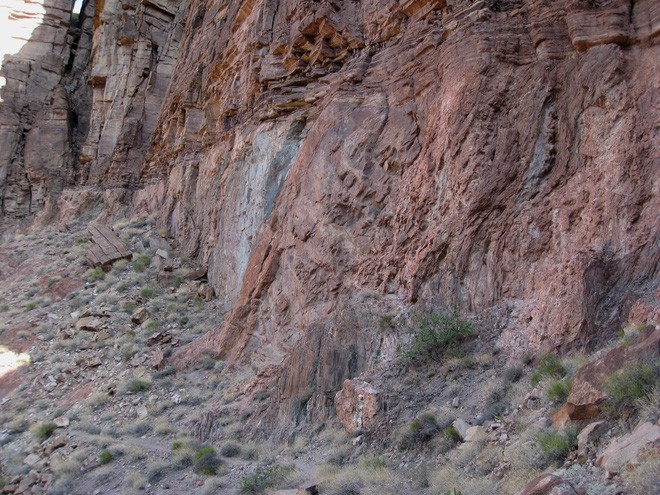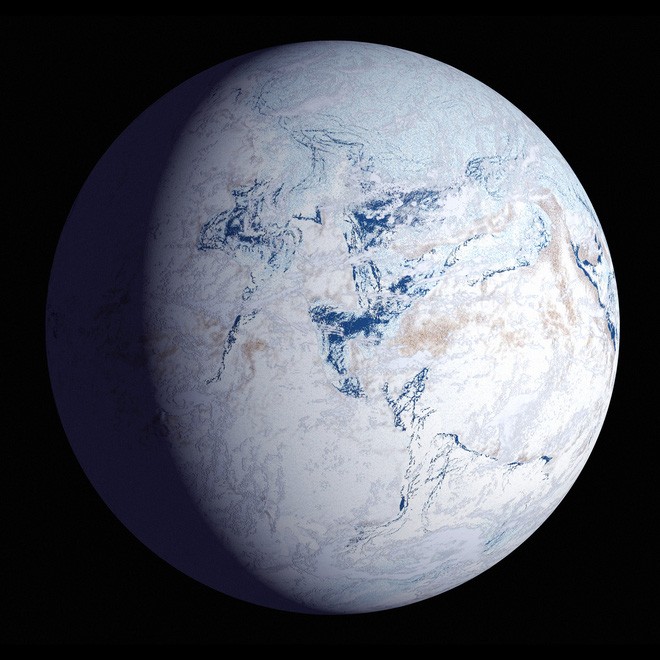Science has sought a solution for a billion-year period that has disappeared from Earth's history
Sometimes, we suddenly forget what we are doing, what we are doing. This unpleasant experience makes you feel that the flow of time you live is suddenly a small stretch. But this feeling is nothing compared to our billion-year-old Earth: in Earth's history, there have been 'memoryless' areas of the Earth that lasted for hundreds of millions of years.
It is possible to confirm the existence of these historical gaps on Earth's geological characteristics: archaeologists discovered that two layers of rocks dating from two distant distances lie close together; this gap could be up to 1.2 billion years. This suggests that somehow nature made sediments of this period not appear in the soil.

The Great Unconformity is a void in the Earth's geological history.
These gaps seem to laugh at our attempt to understand the Earth's past, because they are proof that a period of time has disappeared mysteriously. However, scientists can rely on that to learn how to read Earth's memories, as well as how we count the number of tree rings to deduce the age of the giants.
' A big question, covering all, is the difference between a complete sediment and a sediment that has lost several layers due to erosion ,' wrote geologist Rebecca Flowers from the University of Colorado Boulder. ' Another point is that [it helps us] understand the link between phenomena that occur on the surface (such as erosion), processes that take place in the ground, and changes that have long-lasting effects on birth. study, climate or environment . '
Professor Flowers is the new research author published Monday in the journal PNAS. She points out that the new findings involve one of the most known gaps in Earth's history, The Great Unconformity, appearing on many layers of sediment throughout the Earth.

Researcher Rebecca Flowers.
This gap stretched from about 550 million years ago (the period just before complex living organisms began to appear) to over 1 billion years ago (when microorganisms were still 'dominating' the Earth).
Scientists hypothesize that the fossils during this period were eroded due to the effects of the Earth's time of almost total freezing.
However, in the new report, Ms. Flowers and her colleagues made a new opinion about the formation of historical gaps: this is a feature of tectonic plates in each region, not due to any global phenomenon. . They concluded so when analyzing granite fossils at Mount Pikes, Colorado. This is not the only place Ms. Flowers gets her research sample.
' We work in many other archaeological areas across North America, including the Grand Canyon, perhaps the most famous place where the Great Rift appears. We plan to visit new archaeological sites on other continents, '' Flowers said.
' The purpose of this is to determine whether a global phenomenon, as many scientists have assumed, creates erosion leading to the emergence of the Great Gap, or whether there are multiple Deviations. appear at different times, different places, and different reasons . '

Once upon a time, the Earth looked like this.
To solve this problem, the team of crystalline and crystalline research aims to reconstruct the thermal history (the technique of dating layers) of sedimentary layers. The results showed that the older sediment layer eroded before the Earth entered the first ice age, which indicates that the Great Gap did not occur due to the impact of the erosion caused by the ice.
The results also led researchers to suspect the previous hypothesis, which suggested that erosion along with the formation of the Great Gap caused nutrients to fill the surface of the Earth, creating an explosion. Cambrian period - the time when complex living things appeared at 541 million years ago.
' If erosion occurred a few hundred million years before the Cambrian explosion, it would mean that these two phenomena, the explosion of life and the Great Devour erosion, were unrelated ,' Ms. Flowers explained. 'Our research results show that at the Peak of Pikes, the erosion marks that made up the Rift occurred several hundred million years before the Cambrian boom '.
The team believes that geological activity related to the formation and separation of the Rodinia supercontinent caused the Great Gap at Mount Pikes to appear. However, the nature of the Great Gap is still unknown - the memory gap in Earth's history. It takes more research on the other distances scattered on Earth to be able to draw a full picture of this lost time.
You should read it
- Void keywords in JavaScript
- The qsort () function in C
- Cleaning your washing machine's sediment filter is simple with these simple steps
- The Earth used to be purple and 8 secrets of little surprise
- The function bsearch () in C
- Calculated the time when the 'Moon touched the Earth'
- Science explains why Venus has so few volcanoes
- What is the loudest sound on Earth? What makes the loudest sound on Earth?
May be interested
- See the wonderful images of the world's first computer layout
 let's tipsmake.com review the first computers appeared in the world - the machines marked a great progress of science and technology in human history!
let's tipsmake.com review the first computers appeared in the world - the machines marked a great progress of science and technology in human history! - OpenAI may soon run out of money because of AI training
 based on internal financial documents related to openai, the information believes that the company behind chatgpt is spending about 7 billion usd on ai testing and 1.5 billion usd on personnel this year.
based on internal financial documents related to openai, the information believes that the company behind chatgpt is spending about 7 billion usd on ai testing and 1.5 billion usd on personnel this year. - 9 apps that replace WhatsApp really guarantee your privacy
 when the giant social media company bought everyone's favorite mobile messaging app, whatsapp, users were promised that their data would be safe and private. that promise is still there but consumer confidence has gradually disappeared and many of them have sought alternative applications.
when the giant social media company bought everyone's favorite mobile messaging app, whatsapp, users were promised that their data would be safe and private. that promise is still there but consumer confidence has gradually disappeared and many of them have sought alternative applications. - Discover the ideal time to do everything in the day by age
 let's explore the ideal time to do everything in a day-by-day period below!
let's explore the ideal time to do everything in a day-by-day period below! - IBM acquired Red Hat for $ 34 billion, the acquisition of the largest software company in history
 yesterday (october 29, 2018) ibm announced that it is conducting red hat, an open source software manufacturer for $ 34 billion. all shares in red hat will be paid by ibm at a price of $ 190 per share.
yesterday (october 29, 2018) ibm announced that it is conducting red hat, an open source software manufacturer for $ 34 billion. all shares in red hat will be paid by ibm at a price of $ 190 per share. - Scientists find the true cause of the giant animal extinction in Australia
 50000 years ago, the australian continent still had many different beasts, but they disappeared in a short period of time, leaving a mystery for humankind.
50000 years ago, the australian continent still had many different beasts, but they disappeared in a short period of time, leaving a mystery for humankind. - Shocking: CEO just condemned Pi, Bybit exchange was immediately hacked for more than 1.5 billion USD in cryptocurrency
 the biggest theft in history just happened, causing the bybit cryptocurrency exchange to 'evaporate' 1.5 billion usd.
the biggest theft in history just happened, causing the bybit cryptocurrency exchange to 'evaporate' 1.5 billion usd. - Juniper Research: 1.2 billion smartphones will be sold this year
 sales of smartphone sales this year are estimated at 1.2 billion units, 19% higher than the number of 985 million devices in 2013.
sales of smartphone sales this year are estimated at 1.2 billion units, 19% higher than the number of 985 million devices in 2013. - Dropping over $ 110 billion in value after a day, Apple stock 'evaporated' a record in history
 since the end of january, apple has evaporated more than $ 350 billion.
since the end of january, apple has evaporated more than $ 350 billion. - Android 10 years old, 10 times surprised the world
 android has a 10-year history and it has changed everything. not bad with a 10-year journey.
android has a 10-year history and it has changed everything. not bad with a 10-year journey.










 Killed because the meteorite hit first in human history
Killed because the meteorite hit first in human history Scientists were stunned when they discovered the South American frog fossils in Antarctica
Scientists were stunned when they discovered the South American frog fossils in Antarctica Masks made from bra become the best selling products in Japan
Masks made from bra become the best selling products in Japan A mask asteroid flies across the Earth
A mask asteroid flies across the Earth What are floors B, G, R in the elevator?
What are floors B, G, R in the elevator? MyTV Multiscreen - the perfect multi-screen feature on the rise of technology television
MyTV Multiscreen - the perfect multi-screen feature on the rise of technology television